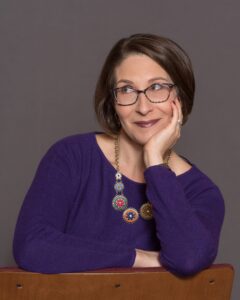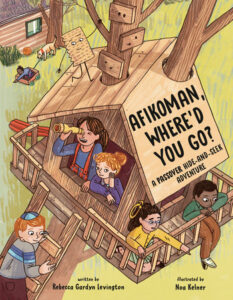In Rebecca Gardyn Levington’s picture book AFIKOMAN, WHERE’D YOU GO? A PASSOVER HIDE-AND-SEEK ADVENTURE (Rocky Pond Books, 2023) illustrated by Noa Kelner, youngsters at a seder turn a home upside down trying to find the elusive afikoman. The illustrations are packed with fun detail, and readers will delight in the afikoman searching antics. I’m delighted to chat with Rebecca about Jewish traditions, writing in rhyme, and more. Welcome, Rebecca!
What inspired you to write about finding the Afikoman? Why do you think it’s important to share the tradition with young readers?
During my own childhood seders, searching for the afikoman was the absolute highlight of the holiday. I have fond memories of my sister and I (and other family friends) tearing through the house, upending couch cushions, throwing open cabinets, and digging through drawers to find it! (My guess is that my mom has less fond memories of this! Lol).
This memory was the impetus for writing this story, along with a longtime desire to do a fractured fairytale version of The Gingerbread Man. After I’d written a draft, I thought: how fun would it be if I could also find a way to involve the reader in this crazy race around the house? That’s when I remembered my fondness for Where’s Waldo books as a kid and also my own boys’ love of all the Richard Scarry books, in which they searched through seas of purposefully busy illustrations in order to find tiny little Goldbug.
Growing up Jewish in a predominantly non-Jewish town, I often felt like I was “other” and I very rarely saw myself in the books I read. I think it is important to share Jewish traditions like this one in picture books so that Jewish kids see themselves and their experiences in books and know that their family rituals and holidays matter.
Equally as important is sharing Jewish traditions with non-Jewish kids. I was thrilled when Lauri Hornik at Rocky Pond, an imprint of a large publisher (Penguin Random House), acquired this book because it means (I hope!) that it will find its way into the hands of kids from all different backgrounds who will enjoy reading about and participating in a new (and fun!) tradition. As creators, one of our goals is to help kids understand and have empathy for one another – and the best way to do that is to expose them to stories that highlight each other’s worlds.

AFIKOMAN, WHERE’D YOU GO? is written in rhyme. How do you decide when to write in prose and when to write in rhyme?
These days, I write in rhyme 99% of the time (there I go again!). I have always loved the sound and rhythm of words, as well as playing with puns, idioms, and lyrical language, bringing them
together in new ways to create a specific mood or emotion. The added challenge of doing all that within the very structured confines and rules of meter, to me, just makes it even more fun It’s the absolute best puzzle. There is true magic in finding the perfect words to encapsulate what I want to say in exactly the right way — all within a single line of verse.
I know there are some people who believe that only certain type of books – toddler board books or inspirational picture books, for instance – “need” to rhyme. But I disagree. There are so many books published in all kinds of categories that use rhyme beautifully – from silly character-driven narratives, to soothing bedtime books, to nonfiction STEM books, and everything in between. I believe any type of book can be written in rhyme, as long as the tone of the meter chosen and the choice of words perfectly match the tone of the story you are trying to tell. Easier said than done, for sure!

Good rhymes are not easy to write, but must be effortless for the reader. Do you have any advice for aspiring poets?
My best advice is to only write in rhyme if you know what you are doing. Please don’t just “wing it” or think you “have an ear for it.” Yes, it is great if you have a musical ear, but understanding and applying the rules of meter to your manuscript is a skill that needs to be learned and practiced. It is art, yes, but also science, and much like brain surgery, you probably shouldn’t be doing it until you understand what you are doing.
There are many resources I could give you, but the absolute BEST thing I ever did for my career was to take Renee LaTulippe’s Lyrical Language Lab class (https://www.reneelatulippe.com/lyrical-language-lab/). Renee offers an “Interactive Course” in which she offers feedback, as well as a “Self-Study” option. I highly recommend the former if you can afford it and the scheduling works, but either will give you everything you need to know. Renee also has a fabulous FREE YouTube channel where she has a ton of videos to get you started: https://www.youtube.com/@LyricalLanguageLab. (And no, I do not get any kickbacks from Renee. Her class truly taught me everything I know so I’m happy to share her as a resource).
One tip I always give is to have someone who has never seen your story read it out loud to you. It is the absolute best way to hear exactly where they are stumbling on the and/or where your rhyme choices feel forced or too simple. And this might sound obvious, but anyone who wants to write rhyming picture books needs to be reading and studying rhyming picture books constantly. One thing I like to do is to type out the text of a manuscript, scan its meter and figure out the rhyme scheme. When I do this, I pay close attention to how often a refrain is used, how the author develops their story or arc, how they use page turns to build tension, etc. Remember, a well-rhymed picture book still has to tell a good story!
What were your thoughts when you first saw the art by Noa Kelner?
OMG, the illustrations in this book are AMAZING! I love how intentionally busy, bright and colorful all the spread are. And Noa brought so much fun to this story! When I initially wrote the text, I was thinking of Afikoman as more of a smarmy, snarky, dislikeable character, but Noa drew him more as a silly trickster, which makes so much more sense and works so wonderfully in this book.
Also, Noa is a master of the fake-out! I obviously know where Afikoman is hidden on each spread, but when I show the book to family members and kids, they have so much trouble finding him. Noa intentionally used lots of browns and beiges to provide camouflage for Afikoman and she included many red herrings to purposefully trick the reader. This book would not be nearly as fun without Noa’s incredible art.

Thank you, Rebecca!
Rebecca Gardyn Levington is a children’s book author, poet, and journalist with a particular
penchant for penning both playful and poignant picture books and poems – primarily in rhyme.
She is the author of BRAINSTORM! and WHATEVER COMES TOMORROW and has seven
additional rhyming picture books forthcoming, including AFIKOMAN, WHERE’D YOU GO? A
Passover Hide-and-Seek Adventure (Penguin Random House/Rocky Pond Books, 2024), LITTLE
DREIDEL LEARNS TO SPIN (Scholastic, 2024), WRITE HERE. WRITE NOW! (Capstone,
2025), I WILL ALWAYS BE… (HarperCollins, 2025), and FINDING FORGIVENESS: A Rosh
Hashanah Story (Macmillan/Farrar, Straus & Giroux, 2025). Rebecca’s award-winning poems
and articles have appeared in numerous anthologies, newspapers, and magazines. She lives in
Summit, New Jersey with her family. Find out more about Rebecca and sign up for her monthly
newsletter at www.RebeccaGardynLevington.com.
What an exciting, beautifully illustrated book! It brings back memories of my own family Seders, also in a predominately non-Jewish town (New Orleans). Oh, the hunt for the afikoman!!
Thanks for the introduction to this new title! Going to hunt for it now. 🙂